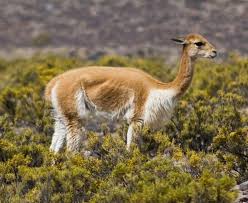The Resilient Vicuña: South America’s Precious Camelid
The vicuña (Lama vicugna), a delicate and graceful creature native to the high Andes of South America, is one of the continent’s most cherished animals. Known for its luxurious wool, which has been coveted for centuries, the vicuña has a rich history intertwined with the cultures of the Andean people, particularly the Inca civilization. Today, while the species has made a remarkable recovery from the brink of extinction, it continues to face challenges that require ongoing conservation efforts.
The Vicuna’s Unique Features and Habitat
Vicuñas are the smallest and most delicate of the South American camelids, a group that also includes llamas, alpacas, and guanacos. They are characterized by their slender build, with a body length of about 1.5 meters (5 feet) and a shoulder height of approximately 85 centimeters (3 feet).
Their weight ranges between 35 and 65 kilograms (77-143 pounds), making them nimble and agile, well-adapted to the harsh conditions of the Andes.
Vicuñas are found at altitudes ranging from 3,200 to 4,800 meters (10,500 to 15,700 feet), where they graze on the sparse vegetation of the high-altitude plains. These areas are marked by extreme temperatures, with warm days and freezing nights, and the vicuña’s thick, soft coat is a crucial adaptation that allows it to survive in such a demanding environment.
A Royal Connection: Vicuña Wool
The wool of the vicuña is often regarded as the most luxurious and expensive in the world. Its fibers are incredibly fine and soft, with a natural sheen that has been highly valued since the time of the Inca Empire.
In fact, under Incan rule, vicuña wool was reserved exclusively for royalty, and it was illegal for anyone else to wear garments made from it.
The wool’s rarity and cost are partly due to the fact that vicuñas can only be shorn once every three years, and each animal produces a relatively small amount of wool. Furthermore, vicuñas are wild animals that cannot be domesticated, so they must be captured for shearing in a process that has been carefully regulated to ensure their well-being.
Conservation Success and Ongoing Challenges
The vicuña’s history has not always been one of prosperity. In the 1960s, the species was driven to the brink of extinction due to overhunting and habitat destruction. By 1974, the global population had dwindled to around 6,000 individuals, prompting international efforts to protect the species.
The Convention for the Conservation of the Vicuña, signed in 1969 by several South American countries, marked a turning point in the species’ survival.
These conservation efforts have been remarkably successful. Today, the vicuña population has rebounded to approximately 350,000 individuals. The species is now classified as “Least Concern” by the International Union for Conservation of Nature (IUCN), reflecting its recovery.
However, the vicuña is not entirely out of danger. Poaching, habitat loss, and climate change continue to pose threats to the species. Additionally, while the wool trade is legal under strict regulations, ensuring that local communities benefit fairly from this resource remains a challenge.
Cultural Significance and Economic Value
The vicuña holds a special place in the cultural heritage of the Andean people. It is not only the national animal of Peru, where it appears on the country’s coat of arms, but it also plays a significant role in local traditions.
One such tradition is the “Chaccu,” a ritualistic rounding-up and shearing of vicuñas that dates back to Incan times. This practice is still performed today, with communities coming together to carefully shear the animals and harvest their precious wool.
Economically, vicuña wool remains one of the most valuable natural fibers in the world. However, the distribution of profits from this trade is often uneven, with Andean communities receiving only a small fraction of the final market price.
Efforts to improve this situation and ensure that the local people who care for and protect the vicuñas are justly compensated are ongoing.
The Future of the Vicuña
The story of the vicuña is one of resilience and recovery, but it is also a reminder of the ongoing need for conservation. While the species has made a remarkable comeback from near extinction, its survival is still dependent on careful management and protection.
As global attention to environmental conservation grows, the vicuña continues to stand as a symbol of the delicate balance between human use of natural resources and the preservation of wildlife.
The future of the vicuña depends on maintaining this balance, ensuring that these majestic animals can continue to thrive in the wild while providing economic benefits to the people who live alongside them. Through continued conservation efforts and fair trade practices, the vicuña’s legacy as one of South America’s most iconic animals will endure for generations to come.
Conclusion
In conclusion, the vicuña embodies the intricate interplay between nature, culture, and conservation. Its journey from a symbol of Incan royalty to a species on the brink of extinction, and finally to a conservation success story, highlights the importance of sustained efforts to protect our natural world. The vicuña’s survival is not just a testament to the effectiveness of international collaboration and local stewardship but also a reminder of the ongoing challenges that endangered species face.




